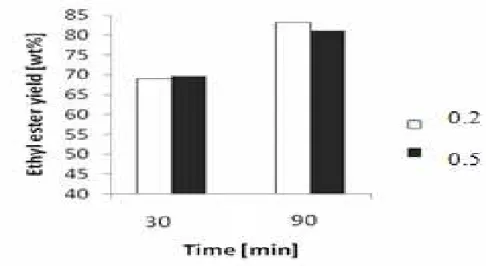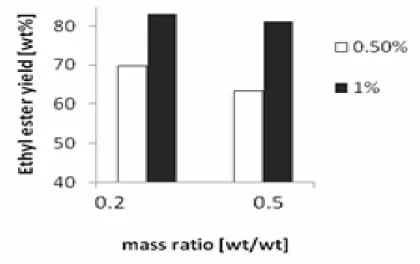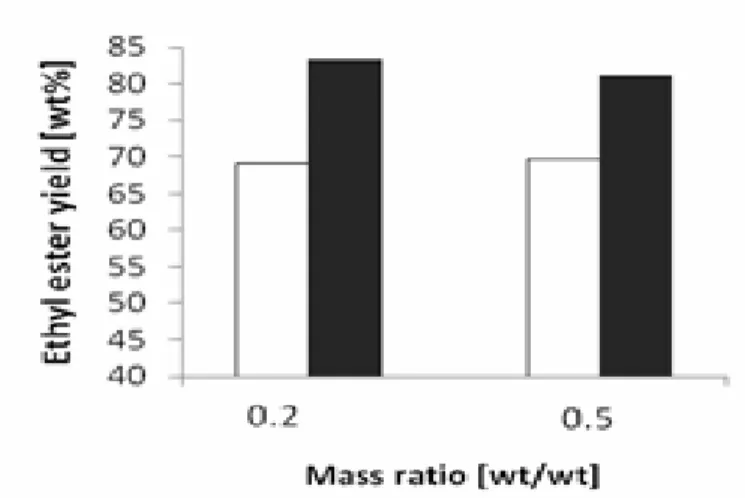E
NERGY AND
E
NVIRONMENT
Volume 1, Issue 4, 2010 pp.675-682
Journal homepage: www.IJEE.IEEFoundation.org
Optimization of factors affecting the production of biodiesel
from crude palm kernel oil and ethanol
David K. Kuwornoo
1, Julius C. Ahiekpor
21 Faculty of Chemical and Materials Engineering, Kwame Nkrumah University of Science and
Technology (KNUST), Private Mail Bag, Kumasi, Ghana.
2 Chemical Engineering Department, Kumasi Polytechnic, P.O. Box 854, Kumasi, Ghana.
Abstract
Biodiesel, an alternative diesel fuel made from renewable sources such as vegetable oils and animal fats, has been identified by government to play a key role in the socio-economic development of Ghana. The utilization of biodiesel is expected to be about 10% of the total liquid fuel mix of the country by the year 2020. Despite this great potential and the numerous sources from which biodiesel could be developed in Ghana, studies on the sources of biodiesel and their properties as a substitute for fossil diesel have tended to be limited to Jatropha oil. This paper, however, reports the parameters that influences the production of biodiesel from palm kernel oil, one of the vegetable oils obtained from oil palm which is the highest vegetable oil source in Ghana. The parameters studied are; mass ratio of ethanol to oil, reaction temperature, catalyst concentration, and reaction time using completely randomized 24 factorial design. Results indicated that ethanol to oil mass ratio, catalyst concentration and reaction time were the most important factors affecting the ethyl ester yield. There was also an interaction effect between catalyst and time and ethanol- oil ratio and time on the yield. Accordingly, the optimal conditions for the production of ethyl esters from crude palm kernel oil were determined as; 1:5 mass ratio of ethanol to oil, 1 % catalyst concentration by weight of oil, 90 minutes reaction time at a temperature of 30 oC.
Copyright © 2010 International Energy and Environment Foundation - All rights reserved.
Keywords: Palm kernel oil, Ethyl esters, Experimental design, Biodiesel utilization, Transesterication.
1. Introduction
In the year 2000, Ghana consumed about 1.6 million tonnes of petroleum fuel and this figure is estimated to exceed 4.5 million tonnes by 2020 [1]. Diesel fuel consumption constitutes about 41% of the petroleum products consumed in the country with consumption growing steadily at an annual rate of about 5% [2]. Due to the increase of petroleum based fuel price in the past years and also greater environmental awareness, Ghana government has set the target on renewable energy utilization through a Strategic National Energy Policy. In this policy, biodiesel will be used to prepare a mixture of 10 % biodiesel in fossil diesel by the year 2020 [1].
Consequently, it is estimated that Ghana will produce about 0.45 million tonnes of biodiesel annually by the year 2020, to meet this target. Thus, the research on renewable energy from domestic resources particularly biodiesel has attracted attention in this country.
with low molecular weight alcohols to break the fatty acid bond from the glycerine backbone while forming three long chain monoesters. Unlike the other processes, transesterification (also called alcoholysis) do not only significantly reduce the viscosity of triglycerides but convert them to the derivatives (monoesters) which are fully compatible with current diesel fuels and can be directly used in modern diesel engines without modification. The key factor affecting the production of biodiesel in terms of production yield and purity of biodiesel include reactant purity, retention time, reaction temperature, catalyst type and concentration, and mass ratio of alcohol to oil. Operating condition used in biodiesel production and property of biodiesel produced depended upon the feedstock source [4].
In spite of the several sources from which biodiesel could be developed in Ghana [5], studies on the sources of biodiesel and their properties as a substitute for diesel have tended to be limited to Jatropha oil. This paper, however, reports the parameters that influence the production of biodiesel from palm kernel oil, one of the vegetable oils obtained from oil palm which is the highest vegetable oil produced in Ghana
.
2. Materials and method 2.1 Materials
Chemicals used for the experiments included 99% ethanol, analytical grade potassium hydroxide pellets, analytical grade hydrochloric acid and crude palm kernel oil (Juabeng oil mills, Ghana). Physical and chemical properties of crude palm kernel oil are presented in Table 1.
The equipment utilised for the batch reaction kinetic experiments included an analytical balance, mixer, a 500 mL batch reactor, a temperature controlled bath, and separating funnel.
Table 1. Properties of crude palm kernel oil
Properties Values
Density at 40/25 oC [kg/m3] 898
Kinematic viscosity at 40 oC [mm2/s] 30.1
Refractive index at 40 oC 1.398
Free fatty acid (Lauric) 1.189
Iodine value [cg iodine/g oil] 19.3
Saponification value [mg KOH/g oil] 250
2.2 Experimental design
The batch reaction kinetic experiments were employed to optimize various parameters in the production of the ethyl esters. A 24 factorial experimental design was used to determine the optimum conditions, four variables were studied at both high and low levels. The response is ethyl ester yield. The low level of ethanol:oil mass ratio was 1:5 and the high level was 1:2 The low level of catalyst concentration chosen was 0.5 % and the high level was 1 % KOH catalyst by weight of palm kernel oil. The low level of temperature was chosen as room temperature (30 °C) and the high level was chosen at 70 °C. The reaction time chosen for the lower level was 30 minutes and 90 minutes for the higher level.
The levels which were chosen for the various variables in this study were based on previous experiments and practical considerations.
2.3 Reaction
The batch experiments were performed in the 500 mL batch reactor. The mixing shaft and impeller ran through the centre joint, while the thermocouple was placed in the outer joint. The last joint was used as the sampling port. The reactor was then placed in the water bath so that the water level was near the top of the reactor.
After the end of the reaction, the mixture was cooled to room temperature and transferred to a separatory funnel. The reaction mixture was then allowed to stand overnight while phase separation occurred by gravity settling. After separation, the biodiesel at the top was carefully decanted into a beaker leaving the light brown glycerol at the base. The biodiesel and the glycerine were washed and their masses recorded.
2.4 Experimental analysis
The experimental results were analyzed using analysis of variance. To estimate an effect or to compute the sum of squares for an effect, the contrast associated with the effect is determined as [6-8].
)
1
)...(
1
)(
1
(
...
=
a
±
b
±
k
±
Contrast
AB K (1)where, A, B,...K are the factors, a, b, ...k are the contrast coefficients
Once the contrast for the effects have been computed, the factor effects is estimated as
) (
2 2
... K ContrastAB...K n
K
AB = (2)
and the sum of squares
2 ... ... ( ) 2 2 K AB K K AB Contrast n
SS = (3)
Where, n is the number of replicates, k is the number of factors. The total sum of square was calculated.
∑∑∑∑∑
= = = = = − = a i b j c k d l n m K ijklm n y y SST1 1 1 1 1
.... 2
2 (4)
The degrees of freedom of the factors, total sum of square and errors where calculated accordingly as
1 − =n Factors (5)
1
2
−
=
kn
Total
(6))
1
(
2
−
=
n
Error
k (7)where, n is the number of replicates, k is the number of factors.
3. Results and discussion
The experimental results, which were obtained from 32 runs according to the experimental design, are shown in Table 2. It indicated that ethanol to oil ratio, catalyst concentration and reaction time were the most important factors affecting the ethyl ester yield. Temperature had little significance on the ethyl ester yield.
3.1Effect of ethanol to oil mass ratio
The mass ratio of ethanol to crude palm kernel oil is one of the most important variables which affect the transesterification and resulting workup procedure. The effect of ethanol/oil mass ratio on crude palm kernel oil biodiesel concentration is presented in Figure 1, 2 and 3. It was observed that a mass ratio of 0.2 generally gave higher biodiesel concentrations. However, there were instances where slightly higher biodiesel concentrations were observed for the 0.5 mass ratios.
the reaction to completion; on the other hand, excess ethanol dilutes the catalyst concentration, leading to a reduction in oil conversion. This may explain the reason for the low ethyl ester concentration.
The analysis of the factor effects showed that, increasing the ethanol to oil ratio actually decreases the ethyl ester yield (Table 3). These results agree with those obtained by O.J Alamu [9] who observed that, the biodiesel yield increases as the ethanol – oil ratio increases only up to a threshold mix. This clearly indicates that the optimum percentage of ethanol (by weight of oil) required for the transesterification of crude palm kernel oil, under the process parameters investigated was 20%.
Table 2. Experimental results
Batch Ethanol : oil ratio [wt/wt]
Temperature [oC]
Catalyst concentration [wt%]
Reaction time [s]
Ethyl ester
concentration [wt%]
1 0.2 30 0.5 30 68.2
2 0.5 30 0.5 30 63.2
3 0.2 60 0.5 30 68.5
4 0.5 60 0.5 30 67.9
5 0.2 30 1 30 69.1
6 0.5 30 1 30 69.6
7 0.2 60 1 30 70.2
8 0.5 60 1 30 68
9 0.2 30 0.5 90 69.7
10 0.5 30 0.5 90 63.4
11 0.2 60 0.5 90 68.8
12 0.5 60 0.5 90 69
13 0.2 30 1 90 83.2
14 0.5 30 1 90 72.1
15 0.2 60 1 90 81.1
16 0.5 60 1 90 71
Table 3. Analysis of variance table and factor effects
Factor Factor Effects Sum of square Degrees of freedom Mean square F value
A -4.325 149.54 1 149.54 17.53
B 0.75 4.5 1 4.5 0.53
AB 1.15 10.58 1 10.58 1.24
C 5.7 259.92 1 259.92 30.47
AC -1.4 15.68 1 15.68 1.84
BC -1.675 22.44 1 22.44 2.63
ABC -1.575 19.84 1 19.84 2.33
D 4.2 141.12 1 141.12 16.54
AD -2.5 50.00 1 50.00 5.86
BD -0.375 1.12 1 1.12 0.13
ABD 0.725 4.2 1 4.2 0.49
CD 3.425 93.84 1 93.84 11.00
ACD -2.375 45.12 1 45.12 5.29
BCD -0.3 0.72 1 0.72 0.08
ABCD 0.2 0.32 1 0.32 0.04
Error 136.53 16 8.53
Figure 1. Effect of mass ratio of ethanol to oil and temperature on ethyl ester yield at 0.5% KOH and 30 min reaction time
Figure 2. Effect of mass ratio of ethanol to oil and catalyst concentration on ehthyl ester yield at 70oC and 30 min reaction time
3.2 Effect of temperature
The effect of temperature on conversion is shown in Figure 4. Temperature had slight effect on ethyl ester conversion, as a result, room temperature is considered to be the optimum operating temperature for ethyl ester conversion.
There are advantages of operating at room temperature. First, the convenience and safety implication during transesterification and the subsequent neutralisation of catalyst and filtration is obvious. Secondly, a low operating temperature can minimise the degree of saponification. Feuge and Gros [10] reported that 50% or more of the catalyst (NaOH) was destroyed in the first 15-20 min due to the formation of soap, whereas no saponification occurred at ambient temperature during transesterification [11]. The resulting soaps do not only lower the conversion of ester, but also cause other problems associated with phase separation.
Figure 4. Effect of temperature on ethyl ester yield at 1% KOH and 90 min reaction time
3.3 Effect of Catalyst concentration
Potassium hydroxide was used as catalyst in this work. The effects of potassium hydroxide concentration on the ethyl ester concentration are presented in Figure 2 and Figure 5. It can be observed that the ethyl ester concentration is higher at the 1% KOH concentration by weight of oil. The ethyl ester concentration decreases with increased ethanol/oil mass ratio. This phenomenon is probably due to dilution of the catalyst by the excess ethanol.
3.4 Effect of time
The ethyl ester concentration increases with increased reaction time (Figure 6). This is due to the increase in mixing and dispersion of ethanol in oil phase with reaction time, which is in accordance with the work of Freedman [12].
Figure 6. Effect of reaction time on ethyl ester yield at 30oC and 1%KOH
4. Conclusion
Four parameters important to the transesterification reaction using crude palm kernel oil, ethanol and KOH were studied at both high and low levels. These included the mass ratio of ethanol to oil, the weight fraction of the catalyst, reaction time and reaction temperature. The following observations were made on analysing the data:
• Catalyst concentration, ethanol to oil mass ratio and reaction time were the most important factor affecting the ethyl ester yield;
• Temperature had little significant effect on the ethyl ester yield;
• Increasing the ethanol to oil mass ratio decreased the ethyl ester yield;
• High levels of temperature and catalyst (KOH) concentration and low levels of ethanol to oil ratio and reaction time decreased the yield;
• Increasing catalyst concentration and time and decreasing the temperature and ethanol to oil mass ratio increased the yield; and
• Increasing all the parameters did not have any appreciable effect on the ethyl ester yield.
Based on these observations, it was concluded that, the optimum temperature for the synthesis of biodiesel from crude palm kernel oil was room temperature, 1% KOH catalyst, 1:5 mass ratio of ethanol to oil, 90 minute reaction time which gave 83.9% production yield.
Acknowledgements
The authors are grateful to GlobalResolve of Arizona State University for their financial assistance provided to Julius C. Ahiekpor.
References
[1] Energy Commission (EC). Strategic national energy plan (2006 – 2020) and Ghana energy policy: woodfuels and renewable energy subsector. Main version, Accra, Ghana, 2006.
[2] National Petroleum Authority, Annual Report, Ghana, 2006.
[3] Kaewta Suwannakarn. Biodiesel production from high free fatty acid content feedstock. PhD dissertation, Clemson University, 2008.
[4] Sergejus Lebedevas, Andrius Vaicekauskas. Research into the application of biodiesel in the transport sector of lithuania. Transport. 2006, vol XXI, No 2, 80–87.
[5] Caminiti, M., Cassal, M., OhEigeartaigh, M., and Zeru Y. Feasibility Study of Biofuels Production in Ghana: Assessing competitiveness and structure of the industry’s value chain. A research on behalf of Technoserve Ghana. The George Washington University, 2007.
[7] Montgomery D.C. Design and Analysis of Experiments, New York, John Wiley and Sons, 5 ed. 2001.
[8] Allen, Michael Patrick. Understanding regression Analysis. Plenum Press, New York, 1997. [9] Alamu O.J. Effect of ethanol-palm kernel oil ratio on alkali-catalyzed biodiesel yield. Fuel, 2007,
08.011.
[10] Feuge A.J, Gros A.T. Modification of Peanut Oil with Ethanol. JAOCS, 1949, 26: 97 – 102.
[11] Mao V.W. Biodiesel kinetics: One-phase base-catalysed methanolysis of soybean oil using tetrahydrofuran as cosolvent. M.A.Sc Thesis, University of Toronto, 1995.



